Preface
Living Physical Geography:
The Big Picture
We are all living physical geography. Weather and climate strongly influence where we live and the types of crops farmers can grow. Almost half the world’s population lives within 150 km (93 mi) of the coast, mostly in large cities situated in bays and estuaries at the mouths of major rivers. Floods and drought, cold snaps and heat waves, volcanic eruptions and earthquakes, soil development and landslides all influence human beings. Physical geography is now more relevant to society than ever. Changes in air quality and climate, losses of habitat and species, soil and water resource demands, and burgeoning renewable energy technologies are all topics that are in the news daily and are all central to the science of physical geography.
The idea for this book originated with my desire to highlight the relevance of physical geography to students’ daily lives and to address the most pressing environmental and resource issues that people face today. Living Physical Geography is unique in that it emphasizes how people change, and are changed by, Earth’s physical systems. This approach creates a student-
Three major themes are woven throughout this book:
Earth is composed of interacting physical systems. The atmosphere, the biosphere, water, and Earth’s crust are major physical systems that interact with and affect one another. Energy from the Sun and energy from Earth’s interior change these systems.
Earth is always changing. The physical Earth is in a constant state of change on many different time scales. The weather changes within minutes, tides ebb and flow over hours, rivers shift their channels across centuries, and over millions of years species evolve, mountains grow and are worn down, and whole continents move.
The influence of people is important. Earth’s land surface, atmosphere, life, and oceans are extensively changed by people. It is not possible to study modern physical geography without considering the influences of human activity.
There are other important themes that also provide the foundation for and enliven the study of physical geography in this book:
Spatial and temporal relationships underpin geographic thinking. Geographers often ask why things occur where they do and how they change through time. For example, why do deserts and rainforests occur where they do? How long have they been in their present locations? How are they changing now? Living Physical Geography examines Earth’s physical features and processes through the lens of geographic space and time.
People depend on Earth’s natural resources. From the energy we use, to the materials in the things we acquire, to the food we eat, people depend on natural resources from Earth’s physical systems.
People are influenced by physical geography. Volcanic eruptions and earthquakes, the development of rich agricultural soils with river flooding, severe weather and climate change, storm protection of coastal cities by wetlands, freshwater supplies from groundwater and streams are a few examples of physical phenomena that influence the lives of people.
Science is driven by people. Scientific inquiry in the Earth sciences is driven by a fundamental curiosity about how the natural world works.
The Structure of Living Physical Geography
Living Physical Geography is divided into four main parts, focusing on the atmosphere, the biosphere, the building up of the lithosphere, and the wearing down of the lithosphere. Each part focuses on the flow and work of energy. Solar energy drives processes in the atmosphere, in the biosphere, and in the wearing down of the lithosphere. Earth’s internal heat energy drives processes that build the lithosphere. Figure GT.11, reprinted here, illustrates the book’s organization.
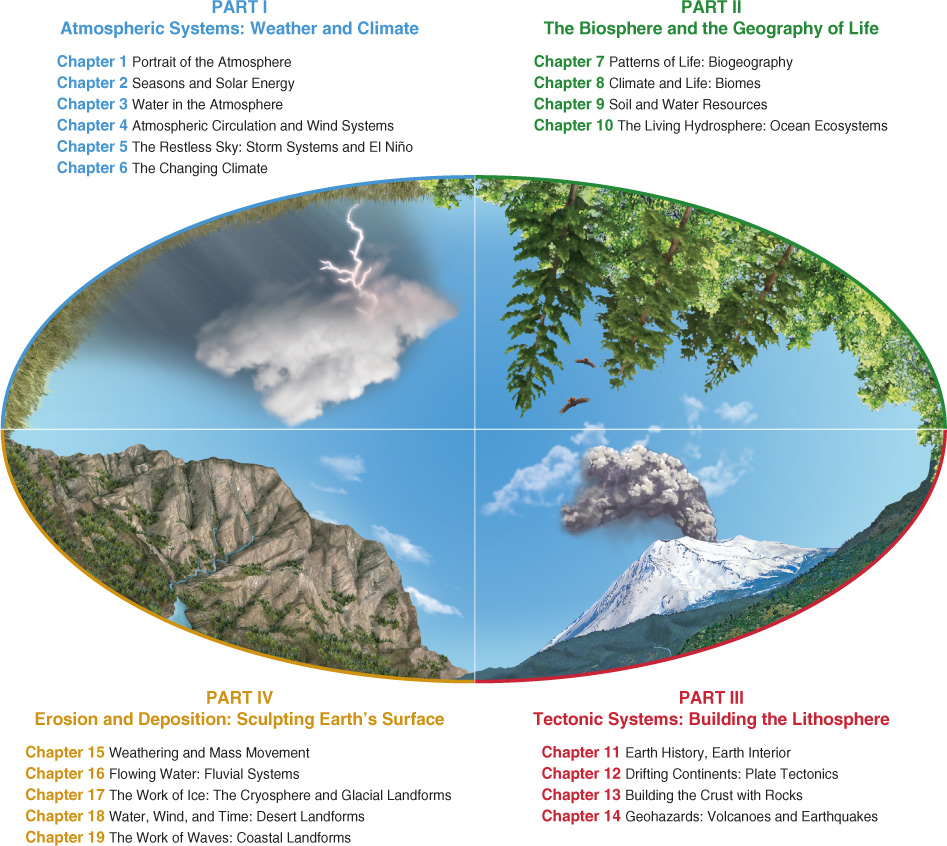
Part I: Atmospheric Systems: Weather and Climate
All meteorological phenomena are powered by the Sun. For example, wind is solar powered because it derives its energy from the unequal heating of Earth’s surface by the Sun. Similarly, rainfall is the result of evaporation of water from the oceans by the Sun.
Part II: The Biosphere and the Geography of Life
Solar energy fuels the biosphere. Life on Earth obtains its energy from the Sun (with the exception of the organisms around some hydrothermal vents on land and in the deep ocean). Plants convert solar energy to chemical energy. When plants are eaten, their chemical energy flows into the organism consuming them.
Part III: Tectonic Systems: Building the Lithosphere
Earth’s internal heat energy (geothermal energy) lifts, buckles, and breaks the crust. Earth’s internal heat also creates new rocks and moves the plates of the lithosphere, forming mountains, valleys, volcanoes, and ocean basins.
Part IV: Erosion and Deposition: Sculpting Earth’s Surface
Solar energy sculpts the lifted crust. Sunlight evaporates water into the atmosphere. That water subsequently falls to the ground as precipitation, then returns to the oceans through flowing streams and flowing glaciers. These streams and glaciers erode the crust, reducing its height and smoothing it.
Living Physical Geography features discussion of the hydrosphere throughout the text as it naturally occurs rather than treating it as a separate entity. For example, water runs through and influences nearly all of Earth’s physical systems, including the atmosphere, ecosystems and biomes, fluvial and glacial systems, and the crust’s groundwater. Additionally, Living Physical Geography devotes an entire chapter to the oceans by examining their physical structure and the geographic patterns of life found in them.
The contents of this book follow a logical sequence, but each instructor approaches the discipline in a different way and may present topics in a different order. For this reason, each chapter is largely self-
Living Physical Geography: Innovations
Living Physical Geography was written to help instructors teach physical geography more effectively. In addition to emphasizing the interactions between physical geography and people, Living Physical Geography offers the following structural innovations:
Humidity is covered before atmospheric pressure and wind. The release of heat energy through condensation drives many atmospheric phenomena and the winds they produce. The wind generated by hurricanes, for example, is the result of condensation of water vapor into liquid water in the atmosphere. To understand why a hurricane’s winds are so strong, it is necessary to first understand the role of water vapor’s latent heat. In this book, atmospheric weather systems are arranged by their spatial scales, from localized mountain breezes to the continent-
wide Asian monsoon. Köppen climate types are covered alongside biomes. In most physical geography textbooks, Köppen climate types and biomes are covered in two separate chapters. Living Physical Geography avoids this redundancy by combining these two compatible topics. In doing so, it establishes the natural link between climate and biomes and illustrates the interconnections of physical geography.
The theory of plate tectonics undergirds all of Part III. Plate tectonics is covered before the topics of mountain building and rock formation, along with geohazards like earthquakes and eruptions, because all these geophysical phenomena are best contextualized within the paradigm of plate tectonics.
Chapter 6, “The Changing Climate,” is devoted to a scientific examination of climate change. Climate change is perhaps the fastest-
moving topic in physical geography. The material presented in this book represents the most up- to- date examples, scientific research, and data on climate. Most students are deeply interested in climate change, and this chapter helps them to understand the current scientific consensus on this important topic and develop independent conclusions based on scientific data. Four chapters are devoted to the biosphere. The geography of the biosphere, including life in the oceans, receives extended coverage in Living Physical Geography. The theme of how people have changed the biosphere runs throughout Part II, “The Biosphere and the Geography of Life.”
A full chapter is devoted to the geography of life in the oceans. The physical and biological oceans are highly relevant to physical geography. Recent exploration and discoveries have improved scientific understanding of marine life, but scientists still know relatively little about the oceans. Chapter 10, “The Living Hydrosphere: Ocean Ecosystems,” reflects recent advances in scientific knowledge of marine ecosystems and an awareness of the most pressing marine environmental issues.
Living Physical Geography Is Written for a Variety of Ways Students Learn
Living Physical Geography is written to engage students and hold their interest, especially those with little background in the Earth sciences. It uses a variety of learning tools to accommodate the different ways that students learn.
The art program and photography support the written text. Many figures illustrate processes in a step-
Living Physical Geography Is an Integrated Textbook/Media Learning Solution
Living Physical Geography is an integrated learning system that combines a textbook with digital media to enhance the teaching and learning of physical geography. The following media components are part of this integrated system:
Exploring with Google Earth
Google Earth is an important pedagogical tool in Living Physical Geography. An “Exploring with Google Earth” activity appears at the end of each chapter. The .kml files required to complete these activities are available on LaunchPad.
Students benefit from using Google Earth because it familiarizes them with the spatial relationships of physical and cultural features of Earth, vividly illustrating the spatial perspective that is essential to geography. Using these exercises, students will be able to quickly navigate to and interpret physical phenomena such as Mount Fuji, the Grand Canyon, the fjords of Greenland, the sand seas of Algeria, and the glaciers of New Zealand. (Answers to the Exploring with Google Earth questions are available in the Instructor’s Manual.)
Animations and Videos
Animations are available for key figures throughout the book. The animations show the movement and development of select physical geography phenomena. For example, the formation of a stratovolcano as it grows by adding layers of ash and lava flows is animated to enhance student learning of this process.
These animations are accessible through LaunchPad, where they are accompanied by questions that assess students’ understanding of the concepts. The animations are also available for immediate access by clicking on the play icon that appears next to the relevant figures.
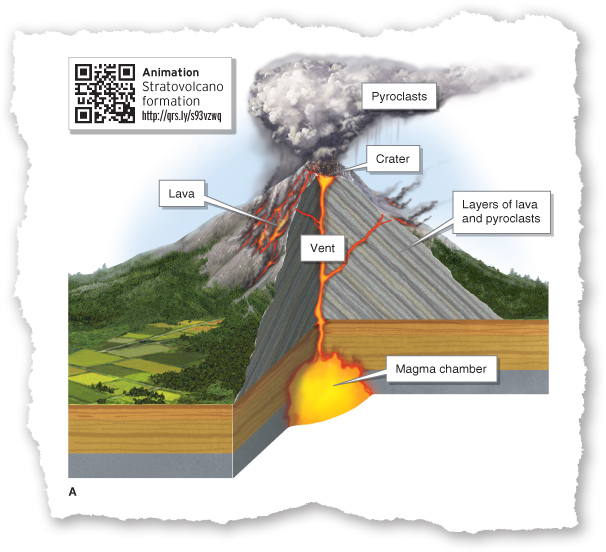
A library of short videos is also available. This collection is designed to support and further develop selected topics in each chapter. Select videos are conveniently accessible through QR codes in each chapter. The complete collection is also available, along with assessment questions, on LaunchPad.
Learning Tools
The learning tools in Living Physical Geography have been carefully designed to provide a multimedia, multimodal approach to the teaching and learning of physical geography.
Chapter Opener with Chapter Outline
Each chapter begins with an image or photo that relates to the contents of the chapter. Each image is briefly described, and reference to the appropriate section within the chapter is provided to stimulate students to seek further information about the image. A brief chapter outline allows the reader to preview the chapter’s contents.
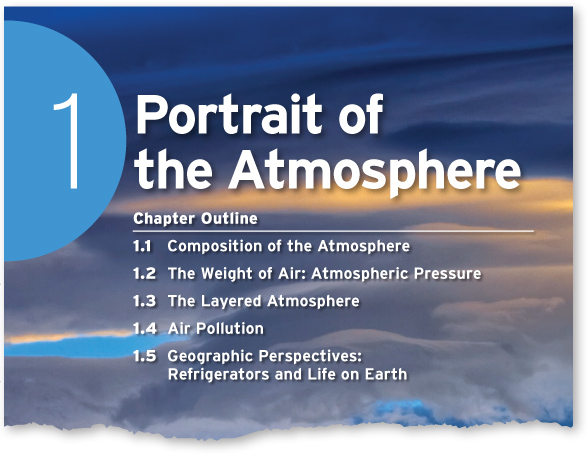
“Living Physical Geography” Questions
The chapter opener also includes a set of “Living Physical Geography” questions. This feature is designed to stimulate interest in the chapter material by asking questions that students may already have. Each question is repeated at the place in the chapter where students will find the answer. Brief versions of the answers to each question are provided at the end of the chapter.

The Big Picture
At the beginning of each chapter, a brief description in a color band orients students to the chapter’s main themes in one or two sentences.

Learning Goals
At the start of each chapter, a list of learning goals is provided. Each numbered section of the chapter begins with a repetition of the relevant learning goal. These learning goals break each chapter down into manageable units while helping instructors focus on the learning outcomes that are important to them.

The Human Sphere
Each chapter opens with a section titled “The Human Sphere.” This opening story briefly explores the relationship between people and a physical phenomenon or process. The key goals of this feature are to illustrate the importance of people to physical geography and to demonstrate the relevance of physical geography to students’ daily lives. Some examples of the Human Sphere topics include air pollution in Wyoming, Asian dust storms, EF5 tornadoes, non-
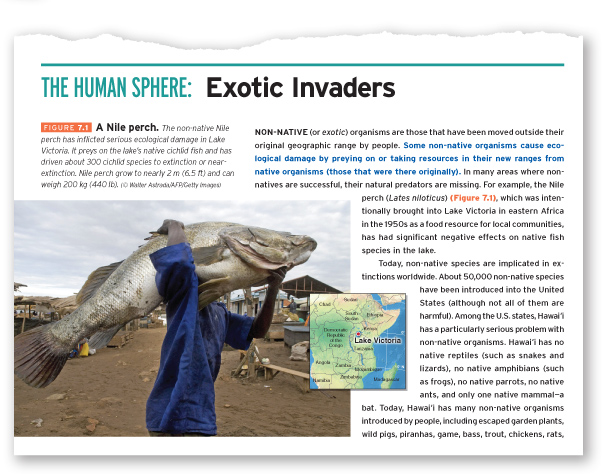

Geographic Perspectives
Each chapter concludes with a section titled “Geographic Perspectives.” These sections are mini-
By providing context for and developing a broader understanding of the material presented in the chapter
By illustrating the connections among seemingly disparate topics within a chapter and across chapters
By providing instructors with self-
contained, manageable units that they can use to facilitate their teaching and stimulate classroom discussion By presenting a balanced view of contemporary environmental issues to encourage critical discussion, reflection, and independent conclusions
Scientific Inquiry
Each chapter has a feature titled “Scientific Inquiry” that reveals why scientists do what they do, how they assess what they know, and how they collect and interpret scientific data. The goal of this feature is to dispel the perception of science as something disconnected from students’ daily lives or career options. Topics range from how stream gauges work and why they are important, to how data are collected from marine buoys and weather balloons to forecast hurricane threats, to how data are collected from ice cores for research into ancient atmospheric chemistry.
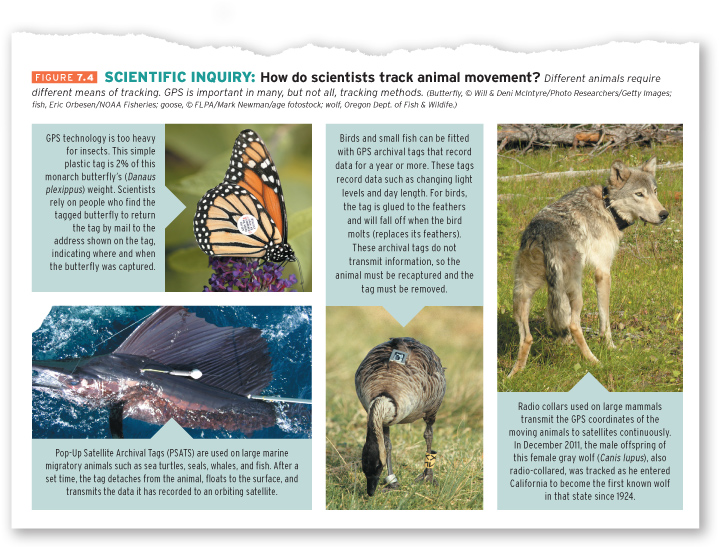
Geo-
The Geo-
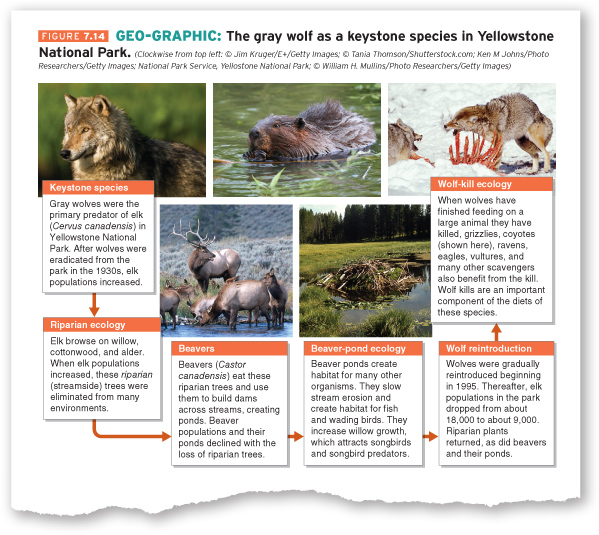
Picture This
In each chapter, the Picture This feature delivers pertinent and intriguing content that supplements the main text and illustrates a relevant principle. The wettest place on Earth, extreme climate events, coal mining, and collapse sinkholes are examples of topics visited in this feature. Each Picture This includes two or three Consider This questions that students can answer by reading supporting text within the feature or the text just preceding it. (Answers to the Consider This questions are available in the Instructor’s Manual.)

Crunch the Numbers
A feature titled “Crunch the Numbers” appears in each chapter at an appropriate point. These short quantitative reasoning exercises ask students to think about how the science of physical geography can be expressed in numbers as well as in words. (Answers to the Crunch the Numbers exercises are available in the Instructor’s Manual.)

Key Information in Blue
Within each chapter, sentences with key information are emphasized in blue. Collectively, these highlights provide a snapshot of the most essential ideas in the chapter.
Chapter Study Guide
Each chapter concludes with a comprehensive study guide. Included are an Exploring with Google Earth question set, Focus Points that summarize the chapter text, a Key Terms matching game, Concept Review questions, Critical-
Locator Maps and Places Visited
All photos whose subjects are located in real geographic space are accompanied by a locator map. The purpose of these locator maps is to emphasize and familiarize students with the locations and spatial relationships of places visited in the book. All places visited are listed in the Places Visited Index at the back of the book. The locations of the places visited are also shown on the world map on the inside front cover.
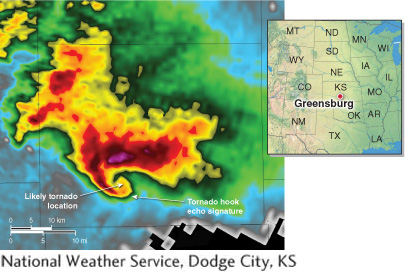
Consistent Use of the Mollweide Map Projection
The Mollweide map projection is used for most world maps in the text. This projection was chosen because it is an equal-
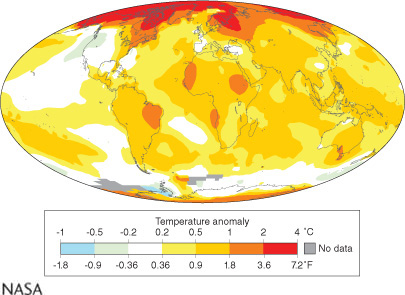
LaunchPad: Resources for Students and Instructors
Our new course space, LaunchPad, combines an interactive e-
For Students
 LearningCurve is an intuitive, fun, and highly effective formative assessment tool that is based on extensive educational research. Students can use LearningCurve to test their knowledge in a low-
LearningCurve is an intuitive, fun, and highly effective formative assessment tool that is based on extensive educational research. Students can use LearningCurve to test their knowledge in a low-
e-
Animations and Videos. Each animation and video is accompanied by a multiple-
Exploring with Google Earth Activities and .kml Files. These activities are online versions of the “Exploring with Google Earth” activities found at the end of each chapter. Here, students can access the .kml files required to complete these activities. Instructors can assign these activities online; results are reported directly to the instructor’s gradebook. A tour of select figures in the text is also provided for more in-
For Instructors
The following resources are available exclusively to instructors on LaunchPad:
Test Bank and Instructor’s Manual, by Bruce Gervais. The test bank contains approximately 2,500 multiple-
PowerPoint Classroom Presentations, by Nicole C. James. A ready-
Textbook Image PowerPoint Presentations. All images from each chapter are provided in PowerPoint format for easy customization.
Textbook Photos and Images. All images and photos from the textbook are available as high-
Living Physical Geography in the Laboratory: Lab Manual to Accompany Living Physical Geography
Theodore Erski, McHenry County College
For schools that offer a physical geography laboratory, Living Physical Geography in the Laboratory is the ideal lab manual to accompany Living Physical Geography. The manual contains 30 lab activities, each broken down into four problem-
Recommended textbook reading before the laboratory activities
Goals of the laboratory activities
Key terms and concepts (from the textbook)
Equipment required. Recognizing that many labs do not have access to expensive equipment, the manual focuses on activities that require only the most basic tools or equipment. Some problem-
solving activities require more sophisticated equipment. Those activities are clearly separated into discrete modules so that instructors can skip them if the necessary equipment is not available. Four problem-
solving modules Summary of key terms and concepts for each lab
The activities in Living Physical Geography in the Laboratory require critical thinking, map and image analysis, data analysis, and occasionally math.
Focus Group Participants
Monika Bachmann, Prince George’s Community College; Leonhard Blesius, San Francisco State University; Karen Blevins, Mesa Community College; Caroline Bour, Blinn College; John Conley, Saddleback College; Heather Davis, Southwestern College; Bryant Evans, Houston Community College; Michael Farrell, Los Angeles City College; Leslie Fay, Rock Valley College; David Fox, Park University; Marc Garrett, Bridgewater State University; Mario Giraldo, California State University, Northridge; Brett Goforth, California State University, San Bernardino; Dafna Golden, Mount San Antonio College; Arleen Hill, University of Memphis; Miriam Helen Hill, Jacksonville State University; April Hiscox, University of South Carolina-